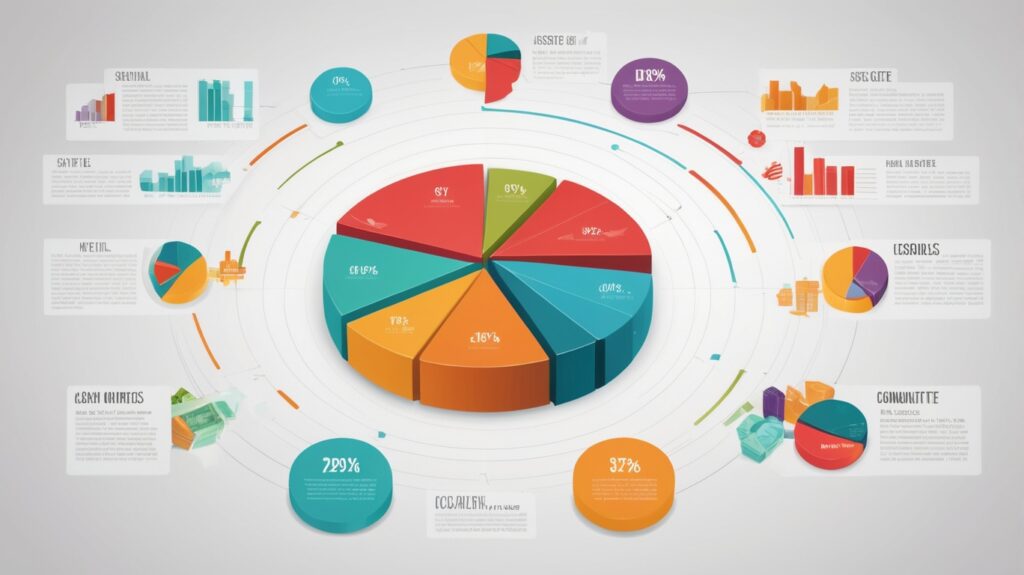Table of Contents
Introductuion to Diversify an Investment Portfolio
Diversification is a foundational risk-management strategy for investors. By combining different assets, a portfolio can smooth out performance: losses in one asset may be offset by gains in another. For example, a 60% stocks/40% bonds portfolio (2000–2020) delivered roughly 85% of an all-stock portfolio’s return while experiencing only 65% of its volatility. This demonstrates how spreading investments across asset classes can dampen volatility and preserve capital. In the sections below, we explain what diversification means and outline practical steps for how to diversify an investment portfolio effectively.

Asset Class Diversification
One fundamental level is spreading investments across different asset classes (stocks, bonds, cash equivalents, etc.). Each behaves differently. Stocks can offer high growth (and high volatility), while bonds and cash are more stable with lower returns. Combining them balances risk. In fact, regulators note that “investing in a mix of stocks, bonds, and cash can be a good strategy” for many goals. For example, a 60% stock / 40% bond split is a classic balanced allocation.
Diversification Within Asset Classes
It’s also important to diversify within each asset class. For stocks, this means holding companies in multiple sectors and of different sizes. Research suggests that most equity diversification benefits can be captured with roughly 20–30 stocks across industries. For bonds, diversify across issuers and maturities. A mix of government Treasuries, corporate debt, and bonds of various lengths helps manage interest-rate and credit risk.
Geographic Diversification
Investing internationally can reduce country-specific risks. Different economies often move in different cycles. By including foreign assets, you can offset domestic downturns. For example, in Q3 2024 U.S. equities returned about 6.2% while international stocks returned roughly 8%. (Global bonds also outperformed U.S. bonds in that quarter.) Many portfolios incorporate 20–40% international stock funds to capture growth abroad.
Sector and Industry Diversification
Within the stock portion of your portfolio, spread investments across multiple sectors (technology, healthcare, finance, energy, etc.). Sectors often perform differently: for instance, in 2022 the energy sector jumped about +59% while the technology sector fell roughly –28%. A diversified sector mix means one industry’s decline may be cushioned by others. You can achieve this by holding sector-diverse funds or selecting representative companies from each sector.
Alternative Investments
Alternative assets lie outside the traditional stock/bond categories and can enhance diversification. Examples include real estate (often accessed via REITs), commodities (gold, oil, etc.), hedge funds, and private equity. Because they often move independently of stocks and bonds, even a small allocation (5–10%) to alternatives can provide an additional hedge. For instance, gold often rises when stocks fall. However, alternatives tend to have higher fees and lower liquidity, so any investment here should be sized appropriately.
Time Diversification and Dollar-Cost Averaging

Your investment time horizon matters as well. The longer you stay invested, the more short-term market swings tend to smooth out. Historically, broad stock markets have averaged around 10% annual returns over many decades, despite frequent ups and downs. Over multi-year horizons, equities tend to deliver strong gains, which is why long-term goals often have higher stock allocations. Short-term needs (like saving for a purchase next year) are typically met with bonds or cash.
Dollar-cost averaging is a related technique: invest a fixed amount on a regular schedule (e.g. monthly) instead of a lump sum. This means you buy more shares when prices are low and fewer when prices are high. Such a systematic approach can reduce volatility: one study found that dollar-cost averaging can cut portfolio volatility by roughly 40% compared to a lump-sum investment. (Over very long periods, investing a lump sum can yield slightly higher returns on average, but dollar-cost averaging helps mitigate timing risk.)
Building a Diversified Portfolio by Risk Profile

Every investor should tailor diversification to their risk tolerance and goals. Below are general guidelines for different risk profiles:
Conservative (Low Risk)
Conservative portfolios emphasize capital preservation. They allocate a large portion to bonds and cash, with only a small stake in equities. A typical conservative mix might be around 15–20% in stocks, 65–75% in bonds, and the rest in cash equivalents. This strategy seeks steady income and protection of principal.
Balanced (Moderate Risk)
Balanced (moderate) portfolios split roughly half in stocks and half in bonds. For example, one might hold about 50% equities (U.S. and international) and 50% fixed income. This blend aims for growth while still providing stability. Many retirement or target-date funds use this approach.
Aggressive (High Risk)
Aggressive portfolios focus on growth. They hold a high percentage in stocks (often 70–90%), with the remainder in bonds or cash. Such portfolios can endure larger swings in the short term for the potential of higher long-term returns. Even aggressive strategies usually keep a small bond slice to cushion volatility.
| Risk Profile | U.S. Stocks | International Stocks | Bonds (Fixed Income) | Cash / Short-Term | Other (REITs/Commodities) |
|---|---|---|---|---|---|
| Conservative | 15% | 5% | 65% | 10% | 5% |
| Balanced | 35% | 15% | 35% | 5% | 10% |
| Aggressive | 50% | 20% | 10% | 0% | 20% |
As shown, conservative portfolios prioritize bonds whereas aggressive portfolios emphasize equities. Balanced portfolios fall in between these extremes.
Rebalancing Your Portfolio

Over time, market fluctuations will shift your portfolio’s asset mix. Rebalancing means selling assets that have grown above their target weight and buying those that have lagged, restoring your intended allocation. In practice, this helps you “buy low and sell high.”
Many investors rebalance on a fixed schedule, such as once a year. Vanguard research suggests that annual rebalancing captures about 85% of the possible benefit while minimizing transaction costs. Another method is threshold rebalancing: only rebalance when an asset class drifts a certain percentage (for example, more than 5% away from its target). Either approach keeps your risk exposure in check.
Conclusion
Diversification is the cornerstone of prudent investing. By combining a variety of assets, sectors, and regions, you reduce the chance that any single event will severely impact your portfolio. Although diversification can’t eliminate all risk, it can significantly smooth out returns. For instance, a 60/40 stock/bond mix has historically captured about 85% of the market’s upside while only taking about 65% of the volatility.
To implement these principles, use broad index funds or ETFs for instant diversification, and rebalance periodically to stay on target. Tailor your asset mix to your goals and time horizon. If you’re unsure, consider consulting a qualified financial advisor. With a disciplined, diversified approach, investors can better pursue steady growth over the long run.
FAQs
What is the best way to start diversifying my portfolio?
Start with broad market funds. For example, buy an index fund that covers the U.S. stock market and another that covers bonds. This immediately diversifies across hundreds of companies and bonds. You could also use a balanced or target-date fund (which allocates across stocks and bonds automatically). Many low-cost ETFs allow you to invest in a diversified mix with one trade. Even with a small amount of money, you can use fractional shares or ETFs to get broad exposure.
How often should I rebalance my investments?
A common approach is to rebalance once a year. This keeps your target allocation roughly in place without excessive trading. Vanguard’s research suggests annual rebalancing captures most of the benefit while minimizing costs. Alternatively, some investors rebalance only when an asset class drifts by a certain margin (e.g. more than 5% off target). The goal is to maintain the intended risk profile.
Is international diversification still relevant in 2025?
Yes. Global markets continue to offer growth opportunities different from U.S. markets. Over the long term, global diversification has often improved returns. (For example, a world stock index averaged about 9.1% annually from 2000–2020, versus ~7.8% for the U.S. S&P 500.) Many experts recommend including 20–40% in foreign stocks. Including international assets reduces risk by not having all investments tied to one economy.
Can I diversify with a small budget?
Absolutely. Many ETFs and mutual funds have low (or no) minimum investments. You can start with just a single share of a broad index ETF (often under $100). Some brokers even offer fractional shares, so you can invest with as little as $50 or $100. Many robo-advisors and target-date funds will automatically spread your contributions across a diversified portfolio. The key is consistency: even modest, regular investments add up over time in a diversified portfolio.
What are common mistakes to avoid when diversifying?
Here are a few pitfalls to watch out for:
- Not diversifying enough: Relying on a single stock, sector, or country can expose you to big losses. Always spread assets across many classes.
- Overlapping holdings: Buying multiple funds that hold the same top stocks offers little extra benefit. Each new asset should add a new exposure.
- Assuming diversification removes all risk: In a severe downturn, correlations can spike (for example, most assets fell together in 2008). Diversification reduces risk but cannot eliminate systemic risk.
- Ignoring rebalancing: If you never rebalance, your portfolio can drift into unintended risk levels. Periodic rebalancing keeps you on track.
- Chasing trends: Buying only last year’s winners or trying to time the market often backfires. Stick to your diversified plan instead.
By avoiding these mistakes and following a disciplined plan – using broad funds, reviewing allocations, and seeking expert guidance when needed – you can effectively diversify your portfolio and manage risk over the long term.
Also Read: What is Asset Allocation? A Comprehensive Guide to Smart Investing




